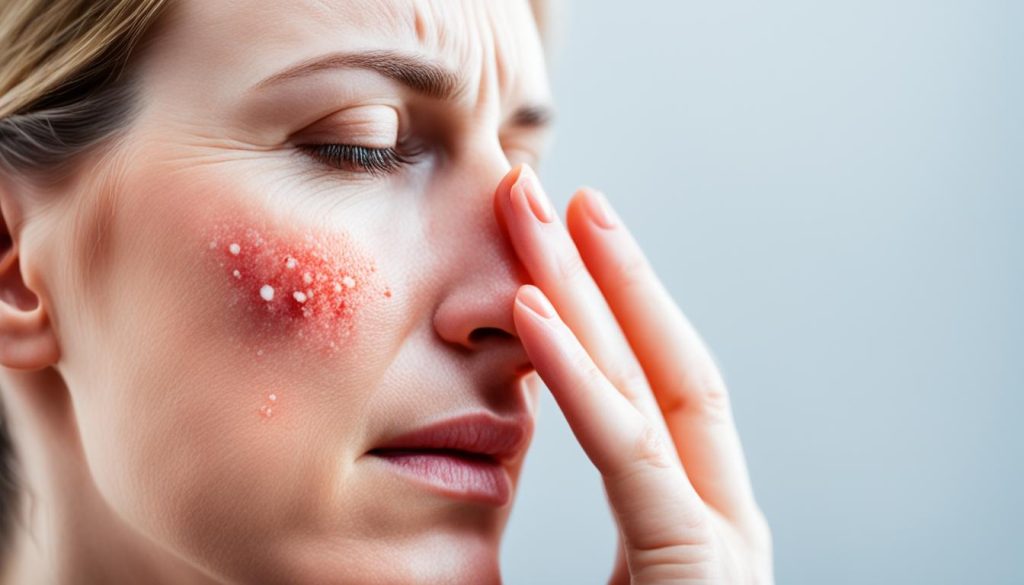Why is My Nose So Itchy on the Outside Meaning?
Are you experiencing persistent itching on the outside of your nose? Well, you’re not alone. Many people wonder why their nose itches on the outside and what it could mean. In this article, we will explore the causes of this discomfort and discuss potential relief options.
Nasal pruritus, or itching inside the nose, can be caused by various health conditions. Itching is often associated with an immune response and the release of histamine. The most common causes of nasal pruritus include allergic rhinitis, sinusitis, nasal polyps, and food allergies.
Allergic rhinitis, both seasonal and perennial, affects a significant percentage of the population and can cause nasal itching. Other factors that may contribute to an itchy nose on the outside include environmental irritants, allergic fungal sinusitis, sleep apnea, and even tumors.
If you’re experiencing persistent nasal itching, it’s important to seek a proper diagnosis from a healthcare provider specializing in ear, nose, and throat disorders. They can help determine the underlying cause and recommend appropriate treatment options.
Relief options for nasal pruritus may include antihistamines, surgery for nasal polyps or tumors, mask adjustments for sleep apnea, avoidance of irritants, and remedies for dry nasal passages. By addressing the root cause of the itching, you can find the relief you need and improve your overall quality of life.
Stay tuned as we delve deeper into the common causes, symptoms, diagnosis, and preventive measures for nasal pruritus in the upcoming sections of this article.
Common Causes and Symptoms of Nasal Pruritus
Nasal pruritus, or itching inside the nose, can be caused by various factors, including allergies, infections, respiratory irritants, nasal polyps, and, rarely, tumors.
Allergic Rhinitis:
One of the major causes of nasal pruritus is allergic rhinitis, which can be seasonal or perennial. Allergic rhinitis is characterized by symptoms such as nasal itching, congestion, sneezing, runny nose, sore throat, fatigue, coughing, and wheezing.
Environmental Irritants:
Certain environmental irritants, such as cigarette smoke and industrial chemicals, can contribute to nasal itching. These irritants can trigger an inflammatory response in the nasal passages, leading to discomfort and itching.
Allergic Fungal Sinusitis:
Allergic fungal sinusitis, which is associated with allergic rhinitis and nasal polyps, can cause inflammation and nasal itching when exposed to fungi. This condition often occurs in individuals with a compromised immune system.
Food Allergies:
In some cases, nasal itching may be a symptom of food allergies. Consuming certain foods can trigger an allergic reaction in some individuals, leading to nasal pruritus and other symptoms like hives, swelling, and difficulty breathing.
Sleep Apnea:
Sleep apnea, a disorder characterized by interrupted breathing during sleep, can also contribute to nasal itching. Individuals using continuous positive airway pressure (CPAP) machines to manage sleep apnea may experience nasal itching due to mask irritation or allergic reactions to the materials used in the mask.
Tumors:
Although rare, tumors in the nasal cavity or sinuses can cause symptoms such as nasal congestion, pain, frequent nosebleeds, and hearing loss. In some cases, these tumors may also lead to nasal itching.

| Cause | Symptoms |
|---|---|
| Allergic Rhinitis | Nasal itching, congestion, sneezing, runny nose, sore throat, fatigue, coughing, wheezing |
| Environmental Irritants | Nasal itching, irritation, inflammation |
| Allergic Fungal Sinusitis | Nasal itching, inflammation, nasal polyps, sinus congestion |
| Food Allergies | Nasal itching, hives, swelling, difficulty breathing |
| Sleep Apnea | Nasal itching, mask irritation, allergic reactions |
| Tumors | Nasal itching, congestion, pain, frequent nosebleeds, hearing loss |
Diagnosing and Treating Nasal Pruritus
When experiencing nasal pruritus, it is important to seek a proper diagnosis from a healthcare professional who specializes in ear, nose, and throat disorders, such as an otolaryngologist or ENT. They have the expertise to determine the underlying cause of your symptoms and prescribe appropriate treatment.
During the diagnostic process, your healthcare provider may ask about your symptoms and medical history to gain a comprehensive understanding of your condition. They may also conduct a physical examination of your ears, nose, and throat to assess any visible signs of irritation or inflammation.
In some cases, additional diagnostic tests may be necessary to confirm a diagnosis or identify any underlying allergies. These tests can include:
- Allergy testing: This procedure helps identify specific allergens that may be triggering your nasal pruritus. Allergy testing can be done through skin tests or blood tests.
- Medical imaging: Your healthcare provider may request imaging tests, such as CT scans or MRIs, to get a closer look at your nasal passages and sinuses. These images can help identify any structural abnormalities, such as nasal polyps or tumors, that may be contributing to your symptoms.
Once a diagnosis is confirmed, treatment for nasal pruritus will be tailored to your specific condition. Common treatment options include:
- Antihistamines: These medications can help relieve nasal itching caused by allergies by blocking the release of histamine, a chemical that triggers allergic reactions.
- Surgery: In cases where nasal polyps or tumors are causing nasal pruritus, surgical intervention may be necessary to remove the growths and restore normal nasal function.
- CPAP mask adjustments: For individuals using CPAP machines to manage sleep apnea, making adjustments to the mask or pressure settings can help alleviate nasal itching.
- Avoidance of irritants: Identifying and avoiding irritants, such as cigarette smoke or industrial chemicals, can help reduce nasal pruritus.
- Remedies for dry nasal passages: Using saline nasal sprays or humidifiers can help moisturize and soothe dry nasal passages, providing relief from itching.
By accurately diagnosing nasal pruritus and implementing appropriate treatment measures, healthcare professionals can help individuals find relief and improve their overall quality of life.

| Diagnosing Nasal Pruritus | Treatment Options |
|---|---|
| – Assessment of symptoms | – Antihistamines |
| – Medical history review | – Surgery for nasal polyps or tumors |
| – Physical examination of nose and throat | – CPAP mask adjustments |
| – Allergy testing | – Avoidance of irritants |
| – Medical imaging | – Remedies for dry nasal passages |
Preventive Measures for Nasal Pruritus
To prevent nasal pruritus, it is important to take proactive steps and implement preventive measures. By identifying and avoiding substances to which you are allergic, you can significantly reduce the occurrence of nasal itching. If you are unsure about specific allergens, consult with a healthcare professional to determine the best course of action. Allergy medications such as antihistamines, nasal decongestants, and steroid nasal sprays can also help manage symptoms and provide relief.
In addition to managing allergies, preventing respiratory infections is crucial in minimizing nasal pruritus. You can achieve this by avoiding close contact with sick individuals, practicing good hand hygiene, and maintaining a strong immune system through adequate sleep, stress reduction, a healthy diet, and regular exercise.
Hydration is essential for maintaining healthy nasal passages. Drinking enough water throughout the day helps prevent dryness, which can contribute to nasal itching. Using a cool mist humidifier or saline spray can also provide relief by moisturizing the nasal passages.

When working in environments where you may be exposed to industrial chemicals, it is important to use appropriate respiratory protection. Using an adequate respiratory mask, such as an N95, can help prevent nasal irritation and protect against harmful substances.
Avoiding cigarette smoke is another important preventive measure. Smoking and secondhand smoke can exacerbate nasal itching and cause respiratory irritation. If you are a smoker, consider quitting to improve overall respiratory health.
For individuals with sleep apnea who use CPAP machines, it is crucial to find a comfortable CPAP mask. Ill-fitting masks can cause discomfort and contribute to nasal itching. Consult with a healthcare professional or CPAP provider to ensure proper mask fit and usage.
Conclusion
Nasal pruritus, or itching inside the nose, can be a bothersome symptom caused by various health conditions. To find relief, it is crucial to seek a proper diagnosis from a healthcare provider who specializes in ear, nose, and throat disorders. By determining the underlying cause of nasal pruritus, you can receive targeted and effective treatment.
Managing nasal pruritus involves a range of treatment options tailored to your specific condition. These may include the use of antihistamines, surgical interventions for nasal polyps or tumors, adjustments to respiratory masks, avoidance of irritants, and the use of remedies for dry nasal passages. Working closely with your healthcare provider will help ensure that you receive the most appropriate treatment plan for your nasal pruritus.
Prevention is also key in managing nasal pruritus. Identifying and avoiding allergens, taking steps to prevent respiratory infections, staying hydrated, using respiratory masks when necessary, and avoiding cigarette smoke can all help reduce the occurrence and severity of nasal pruritus. By implementing these preventive measures, you can minimize the impact of nasal pruritus on your daily life and overall well-being.
In conclusion, seeking a proper diagnosis and treatment, while implementing preventive measures, is crucial in effectively managing nasal pruritus. By working closely with your healthcare provider and following their recommendations, you can find relief and improve your overall quality of life.
FAQ
1. Why does my nose itch on the outside?
Itching on the outside of the nose, also known as nasal pruritus, can be caused by various factors such as allergies, infections, respiratory irritants, nasal polyps, and, rarely, tumors. Allergic rhinitis, both seasonal and perennial, is a major cause of nasal itching.
2. What are the common causes and symptoms of nasal pruritus?
Nasal pruritus can be caused by allergic rhinitis, sinusitis, nasal polyps, and allergic fungal sinusitis. The most common symptoms include nasal itching, congestion, sneezing, runny nose, sore throat, fatigue, coughing, and wheezing. Environmental irritants and sleep apnea with the use of CPAP machines can also contribute to nasal itching.
3. How is nasal pruritus diagnosed and treated?
Nasal pruritus is best diagnosed by an ear, nose, and throat specialist, known as an otolaryngologist or ENT. The healthcare provider may ask about symptoms, perform a physical exam, and may request medical imaging or allergy testing. Treatment options may include antihistamines, surgery for nasal polyps or tumors, mask adjustments for sleep apnea, avoidance of irritants, and remedies for dry nasal passages.
4. What are some preventive measures for nasal pruritus?
To prevent nasal pruritus, it is important to identify and avoid substances to which you are allergic. Allergy medications such as antihistamines, nasal decongestants, and steroid nasal sprays can help manage symptoms. Preventing respiratory infections and staying hydrated can also provide relief. Using a respiratory mask when working with industrial chemicals and avoiding cigarette smoke are additional preventive measures.
5. How can I manage and find relief from nasal pruritus?
Managing nasal pruritus involves seeking a proper diagnosis from a healthcare provider and following their recommended treatment plan. This may include taking prescribed medications, undergoing surgery if necessary, making adjustments to sleep apnea equipment, avoiding irritants, and using remedies for dry nasal passages. Preventive measures and lifestyle changes can also help reduce the occurrence and severity of nasal pruritus.






